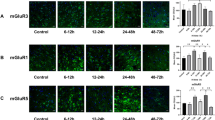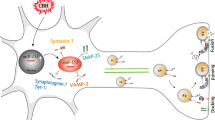Abstract
Objective
Postsynaptic density protein 95 (PSD-95) plays important roles in the regulation of glutamate signaling, such as that of N-methyl-D-aspartate receptors (NMDARs). In this study, the functional roles of PSD-95 in tyrosine phosphorylation of NMDAR subunit 2A (NR2A) and in apoptosis-like cell death induced by oxygen-glucose deprivation (OGD) in cultured rat cortical neurons were investigated.
Methods
We used immunoprecipitation and immunoblotting to detect PSD-95 protein level, tyrosine phosphorylation level of NR2A, and the interaction between PSD-95 and NR2A or Src. Apoptosis-like cells were observed by 4,6-diamidino-2-phenylindole staining.
Results
Tyrosine phosphorylation of NR2A and apoptosis-like cell death were increased after recovery following 60-min OGD. The increases were attenuated by pretreatment with antisense oligonucleotides against PSD-95 before OGD, but not by missense oligonucleotides or vehicle. PSD-95 antisense oligonucleotides also inhibited the increased interaction between PSD-95 and NR2A or Src, while NR2A expression did not change under this condition.
Conclusion
PSD-95 may be involved in regulating NR2A tyrosine phosphorylation by Src kinase. Inhibition of PSD-95 expression can be neuroprotective against apoptosislike cell death after recovery from OGD.
Similar content being viewed by others
References
Beique JC, Andrade R. PSD-95 regulates synaptic transmission and plasticity in rat cerebral cortex. J Physiol 2003, 546: 859–867.
Sattler R, Xiong Z, Lu WY, Hafner M, MacDonald JF, Tymianski M. Specific coupling of NMDA receptor activation to nitric oxide neurotoxicity by PSD-95 protein. Science 1999, 284: 1845–1848.
Kim E, Sheng M. PDZ domain proteins of synapses. Nat Rev Neurosci 2004, 5: 771–781.
Sheng M, Kim MJ. Postsynaptic signaling and plasticity mechanisms. Science 2002; 298: 776–780.
Salter MW, Kalia LV. Src kinases: a hub for NMDA receptor regu lation. Nat Rev Neurosci 2004, 5: 317–328.
Furukawa H, Singh SK, Mancusso R, Gouaux E. Subunit arrangement and function in NMDA receptors. Nature 2005, 438: 185–192.
Popescu G. Mechanism-based targeting of NMDA receptor functions. Cell Mol Life Sci 2005, 62: 2100–2111.
Ulbrich MH, Isacoff EY. Subunit counting in membrane-bound proteins. Nat Methods 2007, 4: 319–321.
Ulbrich MH, Isacoff EY. Rules of engagement for NMDA receptor subunits. Proc Natl Acad Sci U S A 2008, 105: 14163–14168.
Sheng M. The postsynaptic NMDA-receptor-PSD-95 signaling complex in excitatory synapses of the brain. J Cell Sci 2001, 114:1251.
Cui H, Hayashi A, Sun HS, Belmares MP, Cobey C, Phan T, et al. PDZ protein interactions underlying NMDA receptor-mediated excitotoxicity and neuroprotection by PSD-95 inhibitors. J Neurosci 2007, 27: 9901–9915.
Soderling TR, Derkach VA. Postsynaptic protein phosphorylation and LTP. Trends Neurosci 2000, 23: 75–80.
Rosenblum K, Berman DE, Hazvi S, Lamprecht R, Dudai Y. NMDA receptor and the tyrosine phosphorylation of its 2B subunit in taste learning in the rat insular cortex. J Neurosci 1997, 17: 5129–5135.
Barki-Harrington L, Elkobi A, Tzabary T, Rosenblum K. Tyrosine phosphorylation of the 2B subunit of the NMDA receptor is necessary for taste memory formation. J Neurosci 2009, 29: 9219–9226.
Kalia LV, Gingrich JR, Salter MW. Src in synaptic transmission and plasticity. Oncogene 2004, 23: 8007–8016.
Lu YM, Roder JC, Davidow J, Salter MW. Src activation in the induction of long-term potentiation in CA1 hippocampal neurons. Science 1998, 279: 1363–1362.
Tezuka T, Umemori H, Akiyama T, Nakanishi S, Yamamoto T. PSD-95 promotes Fyn-mediated tyrosine phosphorylation of the Nmethyl-D-aspartate receptor subunit NR2A. Proc Natl Acad Sci U S A 1999, 96: 435–440.
Kalia LV, Salter MW. Interactions between Src family protein tyrosine kinases and PSD-95. Neuropharmacology 2003, 45: 720–728.
Hou XY, Zhang G, Yan JZ, Chen M, Liu Y. Activation of NMDA receptors and L-type voltage-gated calcium channels mediates enhanced formation of Fyn-PSD95-NR2A complex after transient brain ischemia. Brain Res 2002, 955: 123–132.
Ali DW, Salter MW. NMDA receptor regulation by Src kinase signalling in excitatory synaptic transmission and plasticity. Curr Opin Neurobiol 2001, 11: 336–342.
Huang Y, Lu W, Ali DW, Pelkey KA, Pitcher GM, Lu YM, et al. CAKbeta/Pyk2 kinase is a signaling link for induction of long-term potentiation in CA1 hippocampus. Neuron 2001, 29: 485–496.
Tauskela JS, Mealing G, Comas T, Brunette E, Monette R, Small DL, et al. Protection of cortical neurons against oxygen-glucose deprivation and N-methyl-D-aspartate by DIDS and SITS. Eur J Pharmacol 2003, 464(1): 17–25.
Sattler R, Tymianski M. Molecular mechanisms of calcium-dependent excitotoxicity. J Mol Med 2000, 78: 3–13.
Liu Y, Zhang GY, Gao C, Hou XY. NMDA receptor activation results in tyrosine phosphorylation of NMDA receptor subunit 2A(NR2A) and interaction of Pyk2 and Src with NR2A after transient cerebral ischemia and reperfusion. Brain Res 2001, 909: 51–58.
O’Brien RJ, Lau LF, Huganir RL. Molecular mechanisms of glutamate receptor clustering at excitatory synapses. Curr Opin Neurobiol 1998, 8: 364–369.
Kornau HC, Seeburg PH, Kennedy MB. Interaction of ion channels and receptors with PDZ domain proteins. Curr Opin Neurobiol 1997, 7: 368–373.
Lin Y, Skeberdis VA, Francesconi A, Bennett MV, Zukin RS. Postsynaptic density protein-95 regulates NMDA channel gating and surface expression. J Neurosci 2004, 24: 10138–10148.
Zhou L, Li F, Xu HB, Luo CX, Wu HY, Zhu MM, et al. Treatment of cerebral ischemia by disrupting ischemia-induced interaction of nNOS with PSD-95. Nat Med 2010, 16: 1439–1443.
Author information
Authors and Affiliations
Corresponding author
Additional information
These authors contributed equally to this work.
Rights and permissions
About this article
Cite this article
Yan, JZ., Liu, Y., Zong, YY. et al. Knock-down of postsynaptic density protein 95 expression by antisense oligonucleotides protects against apoptosis-like cell death induced by oxygen-glucose deprivation in vitro . Neurosci. Bull. 28, 69–76 (2012). https://doi.org/10.1007/s12264-012-1065-5
Received:
Accepted:
Published:
Issue Date:
DOI: https://doi.org/10.1007/s12264-012-1065-5




